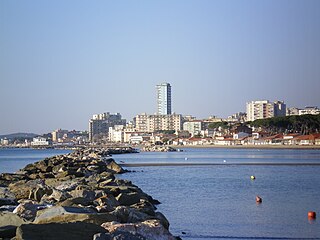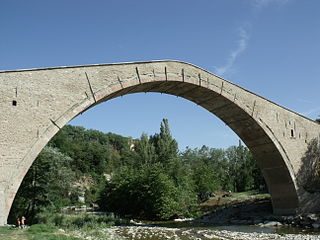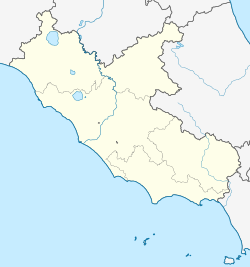
Campobasso is a city and comune in southern Italy, the capital of the region of Molise and of the province of Campobasso. It is located in the high basin of the Biferno river, surrounded by Sannio and Matese mountains.

Magenta is a town and comune in the Metropolitan City of Milan in Lombardy, northern Italy. It became notable as the site of the Battle of Magenta in 1859. The color magenta takes its name from the battle.

Nettuno is a town and comune of the Metropolitan City of Rome in the Lazio region of central Italy, 60 kilometres south of Rome. A resort city and agricultural center on the Tyrrhenian Sea, it has a population of approximately 50,000.

Follonica is a town and comune (township) of province of Grosseto in the Italian region of Tuscany, on the Gulf of Follonica, about 40 kilometres (25 mi) northwest of the city of Grosseto.

Bracciano is a small town in the Italian region of Lazio, 30 kilometres northwest of Rome. The town is famous for its volcanic lake and for a particularly well-preserved medieval castle Castello Orsini-Odescalchi. The lake is widely used for sailing and is popular with tourists; the castle has hosted a number of events, especially weddings of actors and singers.

Bertinoro is a comune (municipality) in the province of Forlì-Cesena, in the Italian region of Emilia-Romagna. It is located on hill Mount Cesubeo, in Romagna, a few kilometers from the Via Emilia.

Nerola is a town and comune of the Metropolitan City of Rome, Latium, Italy.
Cerea is a town and comune in the province of Verona, Veneto, northern Italy.

Cervinara is a town and comune in the province of Avellino, Campania, Italy.
Castelluccio Valmaggiore is a town and comune in the province of Foggia in the Apulia region of southeast Italy.

Castrovillari is a town and comune in the province of Cosenza in the Calabria region of southern Italy.

Altavilla Vicentina is a town and comune in the province of Vicenza, Veneto, northern Italy. It is located southwest of Vicenza.

Carrù is a comune (municipality) in the Province of Cuneo in the Italian region Piedmont, located about 70 kilometres (43 mi) south of Turin and about 30 kilometres (19 mi) northeast of Cuneo.

Arquata Scrivia is a comune (municipality) in the Province of Alessandria in the Italian region Piedmont, located about 100 kilometres (62 mi) southeast of Turin and about 35 kilometres (22 mi) southeast of Alessandria.

Volpedo is a comune (municipality) in the province of Alessandria, in the Italian region of Piedmont, located about 100 kilometres (62 mi) east of Turin and about 30 kilometres (19 mi) east of Alessandria.

Castel del Rio is a comune (municipality) in the Metropolitan City of Bologna in the Italian region Emilia-Romagna, located about 35 kilometres (22 mi) southwest of Bologna.

Bagno di Romagna is a comune (municipality) in the Province of Forlì-Cesena in the Italian region Emilia-Romagna, located about 90 kilometres (56 mi) southeast of Bologna and about 45 kilometres (28 mi) south of Forlì.

Tavullia is a comune (municipality) in the Province of Pesaro and Urbino in the Marche region of Italy, located about 70 kilometres (43 mi) northwest of Ancona and about 15 kilometres (9 mi) southwest of Pesaro. Until 13 December 1938, it was known as Tomba di Pesaro.

Città della Pieve is a comune (municipality) in the Province of Perugia in the Italian region Umbria, located in Valdichiana a few kilometres from the border between Umbria and Tuscany, and about 50 km (31 mi) southwest of Perugia and 11 km (7 mi) southeast of Chiusi in Tuscany.
Sant'Apollinare is a comune (municipality) in the Province of Frosinone in the Italian region Lazio, located about 120 kilometres (75 mi) southeast of Rome and about 50 kilometres (31 mi) southeast of Frosinone.





















